
|
 |

|
 |
Arunima Ghosh: Odissi dance jewellery is intricate and fine, like Odissi abhinaya - Shveta Arora e-mail: shwetananoop@gmail.com Photos: Anoop Arora January 6, 2021 Today, we cannot start where we always start, since there is no regular stage. It is a stage at the dancer's home or, if in an auditorium, one without an audience. Instead of the usual shiny stitched sari, the dancer has neatly draped a 'rehearsal sari', is bereft of most ornamentation and wears minimal makeup, almost like the khandita nayika who, annoyed with her lover, has refused all ornamentation. It is 2020. Due to the pandemic, dancers are performing on makeshift stages - drawing rooms, terraces, studios, sectioned off and curtained - in the costumes and make-up that can be managed without professional help, and this is filmed and broadcast via Facebook, Instagram or, occasionally, paid platforms like Shaale.com. However, since online performances have gradually become more professional, we can again see the nayika bedecked in all the ornamentation and finery that pleases her lover. Though ornamentation in all classical Indian dance forms features a lot of finery and represents the workmanship of the states that they belong to, some ornaments do stand out. I had attended a workshop by Bharatanatyam guru Geeta Chandran at the IGNCA, where she talked briefly about the ornamentation in Bharatanatyam and how those ornaments are influenced by the temple architecture of the south, how every ornament has a significance or connotation, complete with the moon and sun on the head. The ornaments, she said, are inspired by the architecture and structure of the huge temples in south India, with their parikramas, huge kitchens, vahanas for the deity, the water bodies, almost self-sustaining compounds featuring all the elements. The aura of the camphor, the chanting and the intricate jewellery for the huge deities was an inspiration for Bharatanatyam jewellery. However, she said this was only the material ornamentation, and that the real ornamentation for a dancer came from the philosophy and her internal process. In this article, I'm choosing to write about the ornamentation in Odissi. Their head ornamentation has always fascinated me because of the intricate work that you see on it. Also, the ornamentation in Odissi stands out because it is in silver, unlike that in Kuchipudi and Bharatanatyam, which favour gold if the dancer is not experimenting. I spoke to young Odissi dancer Arunima Ghosh, who is based in Delhi, and sholapith artist Netrananda Moharana of Puri, Odisha. ARUNIMA GHOSH Aharya as visual art Ornamentation is a part of aharya abhinaya and aharya is important because it is visual art. The design of Odissi ornaments has been taken from temple sculptures. There is a detailed description in Sarala Das' Odiya Mahabharata. From that description, we know that today, we do not wear as many ornaments as they used to wear earlier, even in the Mahari dance of devadasis. There has been a minimization from that to Odissi. In all the classical dances, Odissi ornaments are unique because they are silver, but even till the 1960s, they used to be in gold. I have heard that Guru Kelucharan Mohapatra used to wear only gold ornaments, but since it was not always affordable, slowly people started using silver. Now, they use white metal and mixed metal also, but basically, it's silver and filigree work - tarokoshi in Odiya. There is filigree work on all ornaments except the belt, the kamarband, which uses different silver designs - there are three lines of different designs in the belt. The maang tika is called mathamani in Odiya. The earrings are of a few different types. There is one that covers the entire ear and has a peacock or flower design with a dangling jhumki. The part that covers just the upper ear is kappa. There are two-three necklaces - the chapasarika or champasarika and the longer one, the hara. The armband is called taita, the chudi is konkona, and the anklet is paunji. The filigree work for the ornaments is done mainly in Cuttack. For all the ornaments used today, the inspiration is either from temple sculptures, or the book Abhinaya Chandrika, or old Odiya texts. The distinctive hairpiece, the white tahiya, is made of sholapith, "Indian cork", which grows mainly in Odisha and Bengal (hence the craftwork is also in Odisha and Bengal). It lasts for a long time if preserved well, but it's very delicate. I keep it in a round metal box, which I have seen Sharon Lowen ma'am also do. It's very delicate and breaks easily, though if you keep it well, it lasts for a long time. But of course, it has to be replaced after a certain time depending on how much care you take of it. Mine is at least ten years old. The colour yellows slightly over time and it starts to break off eventually. My ten-year-old one is intact, but I don't use it because now I use a smaller one, that was why I had changed it. Tahiya, the headgear, represents the Sun Temple in Konark. The outer side is the sun, and the straight path is the Jagannath temple's chuda. As for regional significance, in the belt or bengapatti, you can see the design of the Konark temple wheel. Earlier, there were also other ornaments, like wooden beads, bone ornaments, etc., which are no longer in use. Guru Kelucharam Mohapatra wore ornaments of nothing but gold, so it must have been after his time that silver came into use.  Arunima Ghosh Poetry about ornamentation The poetry about ornamentation is used mainly in choreographies. There is a direct description of ornamentation in "Ardhanarishwara". In "Dheere samire", the sakhi is asking Radha whether she is completely prepared to go to Krishna or not. She sees that Radha is wearing anklets, rushes to her and removes them, and says, 'Now it's fine, you can go.' Again, she watches Radha and says hold your bangles with your hands, so that they don't make any noise. Initially, there is the donning of the shringar, and then getting the message that the sound of anklets and bangles can disturb the relatives. In "Dheere samire", there is no reference to the relatives, just the sakhi saying remove your anklets and even the kamarband. In "Pashyati dishi dishi", there is an elaborate description of shringar. Here, Radha gets a jewellery box, takes out her ornaments, puts on the sindoor, maang tika, earrings, bangles, everything, and then wearing a sari, she sets her hair. There is a detailed description of how she agonizes over going out at the night when her bangles are making a noise. Since her relatives are there, she removes her anklets before going to abhisar. And in "Sakhi hey", it is described how, when Radha and Krishna were together, Radha's earrings and waistbelt were making various sounds. In "Yahi Madhava", looking at a dishevelled Krishna who has returned from a night of pleasure with another woman, Radha wonders what the meaning is of all this. Radha is uttama nayika, so she is furious, though that is not her nature. But by that time, she has been waiting all night, and when Krishna finally comes at the start of the first prahar, with scratches on the chest from another woman, Radha finds herself in a turmoil of emotions. She's completely exhausted, and that's when she gives up. That's when she removes her flower ornaments and lets her hair down - 'What is the meaning of all my shringar?' she asks. 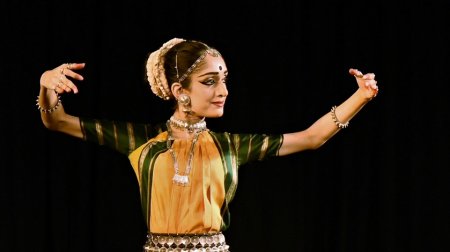 Arushi Mudgal Fine and intricate, like Odissi abhinaya I personally think that Odissi ornaments are very subtle and fine, so they soothe the eyes. They match the dress and makeup completely and are not shiny at all. This subtlety corresponds with the essence of Odissi - not very loud or aggressive, very soothing, very intricate and fine, the kind of intricacy which is in Odissi abhinaya. Even the headgear is like that, since the sholapith is not shiny. When Kumkum Lal, Kumkum Mohanty, Sanjukta Panigrahi etc. were starting out, all the ornaments they wore above the waist, especially above the neck, used to be gold, though the bengapatti was always silver. Then Indrani Rehman came and she started to wear silver. Slowly, the convention changed. But Kumkum Lal and Kumkum Mohanty still wear gold when dancing. Sanjukta Panigrahi shifted to silver eventually. So it was all gold in Odissi but somehow it changed to silver; I haven't been able to find out why exactly. Now, there is very beautiful work in silver ornamentation in Odissi. 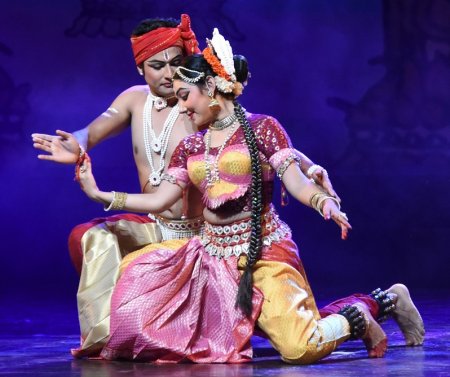 Vrinda Chadha NETRANANDA MOHARANA Sholapith artist Netrananda Moharana in Puri has made the Odissi headgear for many dancers. What is sholapith is and how did you come to be doing this work? In a village by a river in Odisha, we get a wood called sholapith. It is not available all year round, only in the month of Kartik. Like lotuses in swamps, where the flower is above the water and the rest below, most of the sholapith is also submerged in the swamp. Villagers in Puri collect it and sell it to us. At that time, it is green and filled with water inside. We dry it in the sun, and when it changes colour and loses weight, we peel it. Its leaves are like those of tamarind. We cut out pieces as required for the artefact and then we use scissors to shape it. We make flowers etc. out of this. We use big and small knives, scissors, thread and Fevicol (earlier plant gum). All the work is done by hand - no machines. My father, Harihar Moharana, knew Kelucharan Mohapatra, who was like a brother to him. The tahiya you see in Odissi now is my father's work. After he passed away, Kelucharan Mohapatra supported me in doing this work. We used to make pattachitras earlier. When the gates of the Jagannath temple are closed for a fortnight after the Snana Yatra, we have pattachitra seva in the pattachitra puja offered at that time. Now many people learn and watch Odissi, but at that time there were a few, including Sanjukta Panigrahi, a disciple of Kelu babu. Kelu babu lived in Cuttack. Sanjukta could not find the flowers worn in the hair in Odissi and she asked my father to make a tahiya out of sholapith that the dancer could wear quickly. With Kelu babu's efforts, using Sanjukta as a model, the work began. 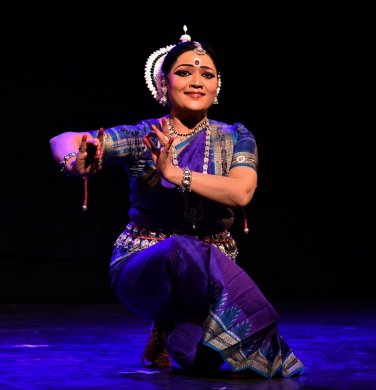 Kavita Dwibedi Dhirendra Nath Pattanaik, who was Secretary of the Odissa Sangeet NatakAkademi, called me after my father died and said, 'You have to do this sholapith work.' I asked, 'Why, I make pattachitra and I get some money that way at least, this will not give me a livelihood.' He said, 'This is your father's work and you have to keep this craft alive.' Since that day, it has been going on. Nowadays, we don't get a lot of money for it - we just about recover the cost of labour. Now you find these objects made out of plastic and other materials as well, which are cheaper. But our work, though light on materials, is all done by hand. There has been some demand from abroad as well - America, Japan, etc. But the lockdown has taken a toll. We have been short of money, and there has been no work. Even if I had it I might not have felt like doing it, with so much shortage. Last year, in Cyclone Fani, I lost a lot of raw material and work. Last year, I married off my daughter, and hence faced a lot of difficulty this year. There was not even one set, not even one flower to be made this year. But since I have pledged to my guru that I will do this work till the end of my life, I will do it. There is not much money in it, but some satisfaction. If the artist keeps it properly, it will last for four-five years at least, but they will have to store and maintain it. Ganda karpoor - camphor - if you put that in the box along with the shola, it lasts longer. I make pattachitras once a year for a few days, but that is seva for the Jagannath temple; we don't charge money for it. I am asking dance gurus to help save this craft and support artists like us. 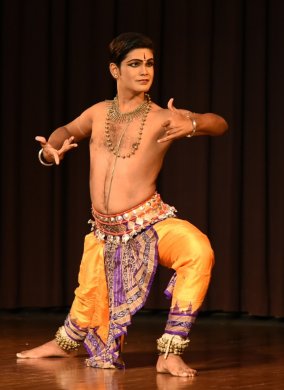 Vinod Kevin I am very grateful to Arunima who, at my request, did such extensive research into the texts for mentions of ornamentation. An art form always has some ancillary artists attached to it who have all been struggling this year. I would request art lovers all around the world to open their hearts and their wallets when they come across any such artist. 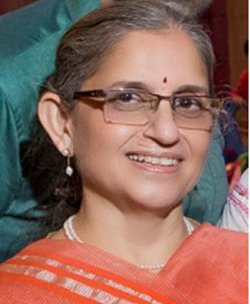 Shveta Arora is a blogger based in Delhi. She writes about cultural events in the capital. Post your comments Please provide your name and email id when you use the Anonymous / blog profiles to post a comment. All appropriate comments posted with name and email id in the blog will be featured in the site. |